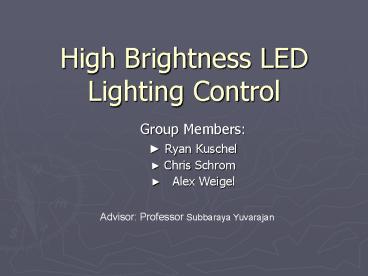High Brightness LED Lighting Control - PowerPoint PPT Presentation
1 / 34
Title:
High Brightness LED Lighting Control
Description:
High Brightness LED Lighting Control Group Members: Ryan Kuschel Chris Schrom Alex Weigel Advisor: Professor Subbaraya Yuvarajan The Problem The earths dependency on ... – PowerPoint PPT presentation
Number of Views:175
Avg rating:3.0/5.0
Title: High Brightness LED Lighting Control
1
High Brightness LED Lighting Control
- Group Members
- Ryan Kuschel
- Chris Schrom
- Alex Weigel
Advisor Professor Subbaraya Yuvarajan
2
The Problem
- The earths dependency on Non-renewable resources
- Having to replace incandescent and fluorescent
bulbs
3
Solution
- High Brightness Light Emitting Diodes (HB
LED) - Benefits of HB LED Lighting
- More efficient compared to fluorescent lighting
- Ability to switch on and off at high speeds
- Life span up to and exceeding 20,000 hours
- Drawbacks of HB LED Lighting
- Increased cost of ownership
- Operates on low voltage DC
- Intensity regulated by current
4
Requirements
- Study the characteristics and develop a Pspice
model of the chosen LED - Build a light structure with several LEDs in a
string - Design and build a power converter to convert
from 120 VAC to the desired DC value.
5
Requirements Continued
- Design a Digital controller to Control the light
intensity - Design a way to protect the LED string from
over-voltage and over-current
6
Choosing a LED
7
Considerations
- Brightness
- Efficiency
- Heat Dissipation
- Viewing Angle
- Life Span
- cost
8
Luxeon K2 Emitter
- Has a brightness of 100 lumens at 3 watts
- 100 watt light bulb produces 1740 lumens
- An efficiency of 33.3 lumens per Watt
- Requires a Heat Sink.
- Viewing angle of 120 degree
- Life span of 50,000 hours
- 6 years running 24 hours a day
- Retails for 3.45
9
Layout Considerations
- Series
- Benefits
- Constant Current through out LED string
- Easy to implement
- Drawbacks
- High voltages required
- If one LED fails the string fails
10
Layout Considerations Cont.
- Parallel
- Benefits
- Constant Voltage required
- If one LED fails others in array continue to work
- Easy to implement
- Drawbacks
- High current required
11
Final Layout
- Series Parallel
- Benefits
- If one fails the others in array continue to work
- For short periods of time
- Drawbacks
- Moderately increased voltage and current
- More difficult to implement
12
Final Layout Continued
- Number of LEDs
- 24 LEDs chosen to be brighter than 100 Watt
incandescent bulb - To operate string at ideal conditions
- 44 Volts DC (3.72 Volt Drop per LED)
- 2 Amps (1 Amp per LED)
13
Power Converter
- Basic power conversion from AC to DC
- Need to impliment a Bridge Rectifier
- The 4 diodes rectify the AC waveform to DC
14
DC Voltage Step-down
- Buck Converter
- Steps down rectified voltage to a more usable
voltage for the load - The LED string requires a voltage of 44 Volts DC
15
Digital Dimmer
- Uses Microcontroller (PIC 16F876)
- Implementing pulse width modulation
- Pulse width modulation
- Utilizes switching properties of the LED
- Varies pulse width from 0 to 100 percent
16
Dimming and Intensifying
- Dimming by narrowing Pulses
- Intensifying by Widening Pulses
- The time that the pulse is high will trigger a
MOSFET to close the circuit
17
Protection from Over-current
- The Pic 16F876 can also be used to provide
protection from over-current - Implements 2 voltage meters and a known
resistance to calculate the current through the
LED array - If the Calculated current is over a specified
current value Pulse width modulation is set to 0 - MOSFET switch is open
18
Project Status
- Modeling the Diode
- Need to match the voltage/current relationship of
the HD LED
19
Modeling HB LED
- Using Pspice we can adjust the Is and n values to
match the HB LED
20
String Simulation
21
LED String
22
Buck Converter Simulation
- Step
23
Microcontroller
- Currently implements the use of the onboard
potentiometer to generate analog input. - Taking the analog input and converting to digital
allows for the pulse width to be controlled by
increasing or decreasing the voltage seen on the
input
24
Adjusting the Pulse Width
- Slowly increasing the duty cycle
- The Duty Cycle at approximately 20
25
Adjusting the Pulse Width
- Duty Cycle at approximately 40
26
Adjusting the Pulse Width
- Duty Cycle at approximately 60
27
Adjusting the Pulse Width
- Duty Cycle at approximately 80
28
Adjusting the Pulse Width
- Duty Cycle at approximately 100
29
Supertex HV9910 IC
- Current Controlling IC
- Uses high voltage junction
- Allows LEDs to be driven at constant current,
rather than constant voltage - By receiving a outside PWM input, chip regulates
buck converter MOSFET - Will provide low voltage power for the PIC
30
Final Configuration
31
Tasks Remaining
- Buck Converter
- Adjust inductor value and duty cycle to get
needed voltage - Digital Dimmer
- Implement debounce buttons to switch between
preset duty - Implement HV9910 IC to utilize its over-current
protection - Build prototype of final LED string
32
Timeline
- Order LEDs, Heat sink, enclosure Thu 8/23/07
- Troubleshoot code Tue 8/28/07 Tue 9/4/07
- Build PCB Tue 9/11/07 Tue 9/18/07
- Troubleshoot PCB Tue 9/25/07 Tue 10/2/07
- Build Prototype Tue 10/9/07 Tue 10/30/07
- Documentation Tue 11/6/07 Tue 11/27/07
33
Budget
- Current
- 8 LEDs _at_ 3.45 each total 27.60
- 1 foot heat sink 15.00
- Total 42.60
- Projected
- 20 LEDs 69.00
- Heat Sinks 30.00
- Pic 30.00
- Enclosure 30.00
- Converter 30.00
- Total 189.00
34
Conclusion
- LEDs are constantly growing in efficiency and in
the near future will be the standard in lighting. - Questions?































